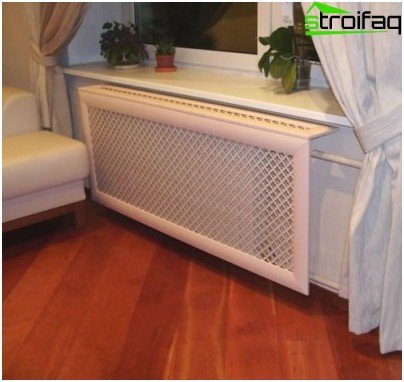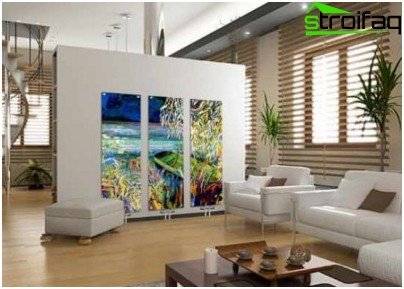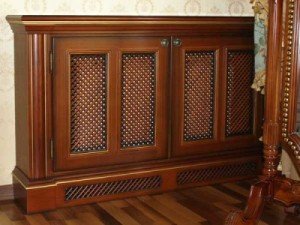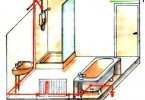Screens and grilles for heating batteries (radiators)
Modern sophisticated design projects demand excellence in every detail. Even new heating radiators able to nullify the whole idea and spoil the overall impression of the interior. What to say about dusty shabby cast iron radiators of the past generation, still confidently occupying places under the windows in old apartments. So what to do in this case? Screens for heating batteries will help to correct the situation..
Content
- Why do you need screens and grilles for radiators?
- Types of data of decorative protective elements
- What radiator screens are made of
Why do you need screens and grilles for radiators?
Consider the main advantages of decorative screens on radiators:
- Reliable protection of radiators from dust. The batteries, as a rule, have a shape that is very difficult to completely clean, and even the back wall of the radiator is almost impossible to wipe. Thermal radiation picks up small particles of dust and spreads around the room, forcing residents to breathe them. The design features of the grilles and screens are such that dust does not get inside, and the heated air circulates freely, without encountering any obstacles.
- The ability to choose their appearance so that the battery merges with the design of the room. Screens for radiators can also turn these devices into a stylish and elegant interior detail..
- Protection against injury from burns or bumps to fins or corners. This item is important for families with small children..
- Improving convection by creating a natural threshold arising in the path of air flow. Due to this, warm air is more evenly distributed in the room.
- Avoid costly replacing all old batteries in the living room.
- Reducing the harmful effects on the human body.
Types of data of decorative protective elements
There are several types of screens:
- flat screens;
- hinged screens without a cover;
- hinged screens with a cover;
- box screens.
Flat designs are usually used for radiators located in niches, as well as for the implementation of original design projects..
Mounted screens are designed for cast iron radiators, they are convenient to use in cases where the radiator is in a niche and immediately above it is a window sill. The inconvenience of this type is that in order to achieve a good result, the front surface of the battery should be parallel to the wall. If the battery protrudes slightly from under the windowsill, it is better to use a hinged device with a cover.

A hinged screen with a cover is used when the battery protrudes slightly from the window sill line
If the radiator needs to be fully decorated, it is slightly skewed or the pipes fitting to it are also planned to be completely closed, it is recommended to use decorative screens for heating radiators made in the form of a box.
What radiator screens are made of
Metal screens for radiators are thin metal boxes painted in white. It is difficult to call them original or elegant, but they have an undeniable advantage – cheapness. More expensive metal screens for heating radiators are made of stainless steel. Of course, this material is beautiful and allows you to create a unique look on the outer surface, but still it’s not always possible to successfully enter them into the interior of the room.
Decorative grilles for heating radiators made of wood are most often custom-made. A noticeable drawback of wooden elements is that temperature changes and changes in humidity in a room can lead to their deformation and drying out. In order to avoid these troubles, wooden screens are made only from valuable species of wood, which leads to a significant increase in their value. But such designs are ideal for an interior made in a country style or in a classic style..
The appearance of MDF panels made it possible to obtain decorative screens for heating radiators with the same attractive appearance as wooden ones, but at the same time with a lower cost. From MDF boards you can make gratings of any complexity, shape, resistant to temperature influences and at the same time very high quality.
For more sophisticated interiors, glass screens made of stained or tempered glass are used. You can apply any pattern to them and turn an ordinary protective screen into a real exclusive piece of furniture, though, due to its fragility, it requires a very careful attitude.

Three glass screens for landscape radiators
The most affordable are plastic screens. But, despite the cheapness, their use in residential premises is not recommended, since plastic tends to emit harmful substances when heated.
Screens and grilles on radiators make it possible to decorate the room, add an element of comfort and completeness to it. Installation of these decor items will allow you to forget about the many problems of maintaining heating radiators. They can be easily removed, washed and even replaced if desired..
You can use screens not only in residential premises, they are successfully used in public and administrative buildings, shopping centers, schools and kindergartens. It is especially good to use them in children’s institutions, this can significantly reduce injuries due to contact with hot batteries.







